Top 16 Project Portfolio Management Software Tools (2026)
Managing multiple projects across clients or subsidiaries can quickly lead to confusion, duplicated work, and limited visibility into progress and performance.
The right project portfolio management software helps teams regain control by unifying projects, finances, and reporting in a single platform.
In this guide, we review 15 of the best tools for strategic portfolio control, resource planning, and performance tracking. You’ll find core features, use cases, real user reviews, and practical advice to help you choose the right solution.
What Are the Best Project Portfolio Management Software Tools?
Here’s a curated list of the best project portfolio management software tools:
1. Productive – Best All-in-One Tool for Project Portfolios and Multi-Subsidiary Companies
Productive is an all-in-one platform built specifically for agencies and professional service providers that manage multiple teams, clients, or legal entities. It combines delivery operations, budgeting, time tracking, and financial reporting in a single place.
Key Features
- Centralized time tracking for internal and billable work
- Financial dashboards with profitability tracking
- Cross-entity resource planning
- Portfolio-wide budgeting and forecasting
- Custom fields for strategic project scoring
- Project-level and portfolio-level reporting
- Utilization and margin analysis dashboards
See All Subsidiaries and Portfolios in One Place
Siloed resource plans create unnecessary chaos that usually looks like double-booked specialists, overworked developers, and idle teammates waiting for handoffs.
Siloing is a common pain point of growing companies: no one has a reliable view of who’s doing what, and when.
Productive solves this by giving operations, project managers, and department leads a shared resource planning board. You can allocate people by project, role, or skill, and instantly see availability across all teams.
Built-in capacity planning tools make it easy to plan ahead and rebalance workloads before anyone gets overwhelmed.
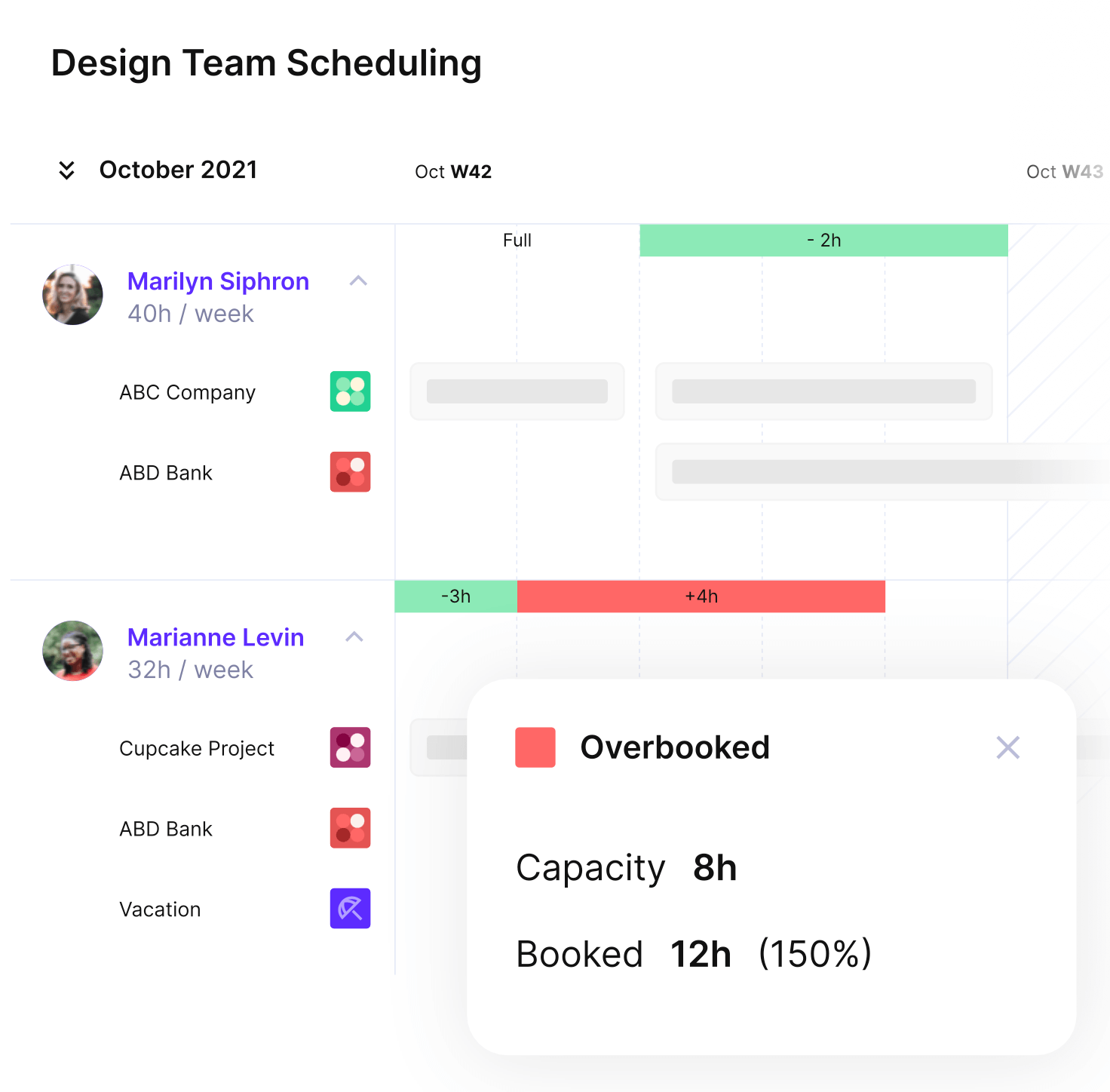
Schedule your team members for future work and prevent overbooking or idle hours.
Plan Resources Centrally Across Portfolios
Without a reliable view of upcoming demand, companies often hire too late or under-allocate their most valuable people. The problem isn’t just who’s scheduled today, it’s whether you have the right people available next week, or next month, when new work lands.
Productive gives operations and project managers a forward-looking capacity view across all portfolios. You can forecast workloads, simulate future needs, and spot resourcing gaps early.
There’s also the amazing feature called Scenario Builder that helps you simulate outcomes and compare different scenarios to maximize profit. This helps teams rebalance ahead of time, reduce last-minute hiring, and prevent overworking the same people.
Benchmark Delivery Across Business Units
It’s normal that each team defines success differently. However, this different definition of success makes it nearly impossible to compare performance across departments or business units.
Some teams track utilization, others focus on delivery timelines, and finance often looks at margins. Productive fixes this by giving everyone access to a single source of truth.
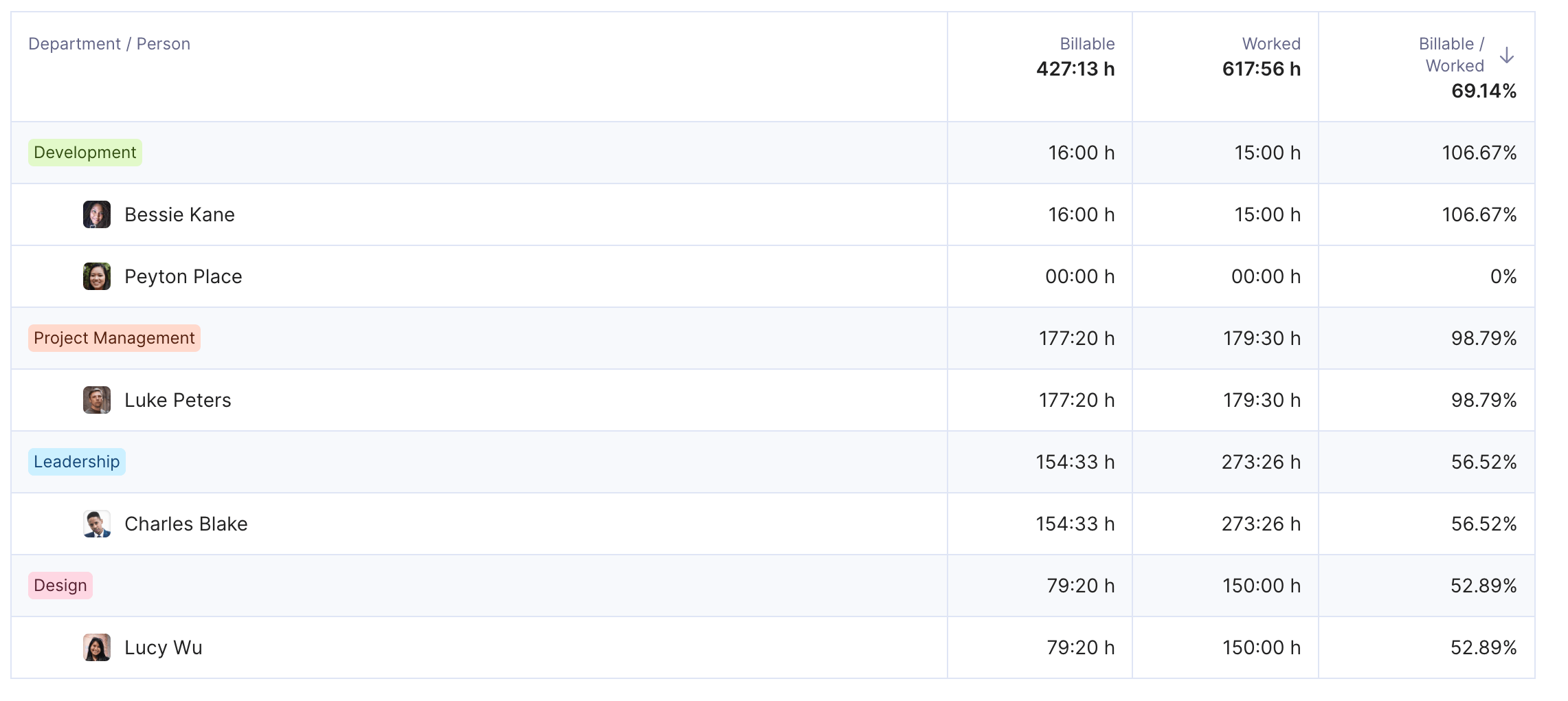
Get real-time utilization metrics of your team’s work hours.
With unified dashboards and consistent KPIs, you can track billable hours, delivery speed, and profitability side by side. This makes performance monitoring simple and supports confident, data-driven decision-making at every level.
Track Budgets, Revenue, and Forecasts in One View
When project budgets, actuals, and forecasts live in separate tools, finance and delivery teams struggle to stay aligned. It’s hard to catch margin erosion early or spot projects drifting off budget.
Productive fixes this with shared financial dashboards that bring project budgets, time tracking, and billing data into one view. You can see expected revenue and profitability by project, client, or portfolio without exporting a single spreadsheet.
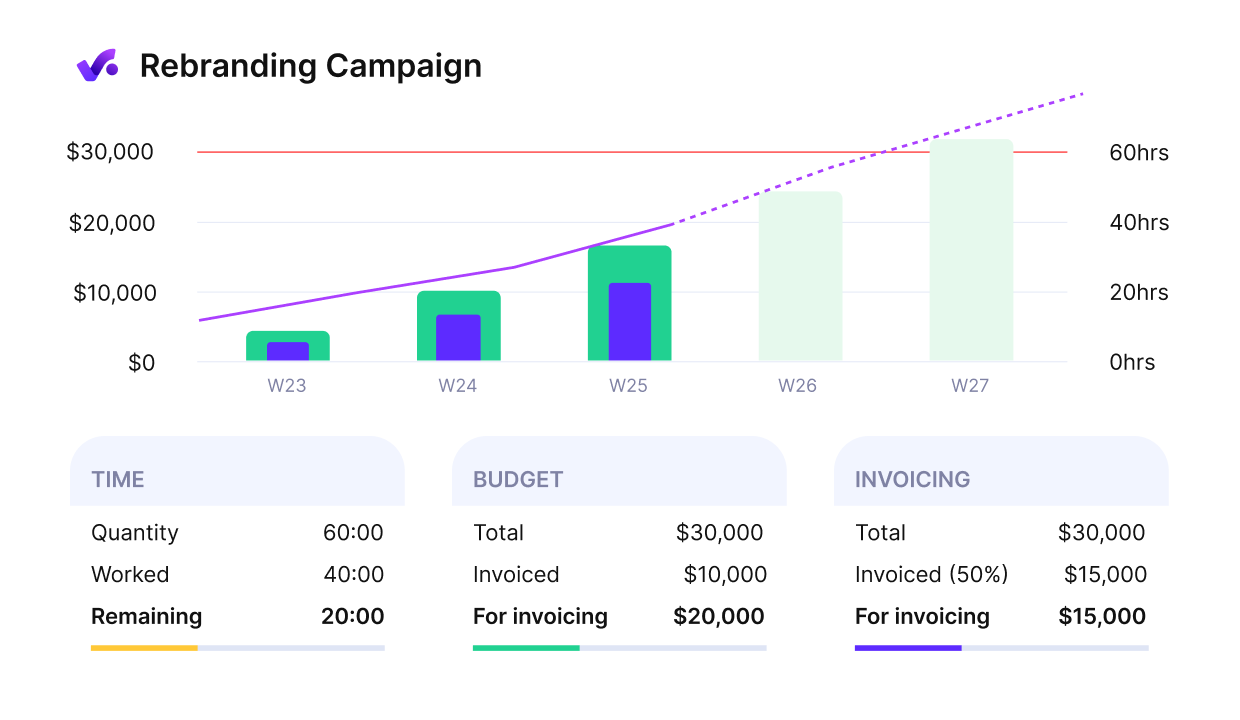
Get an early warning of budget overruns.
This gives both project leads and finance teams the context they need to make faster, smarter decisions.
Manage project portfolios with Productive
Align Project Selection With Business Goals
Sadly, a lot of agencies approve projects based on urgency or internal lobbying, not long-term value. Over time, this clutters the sales pipeline with initiatives that pull teams away from strategic goals.
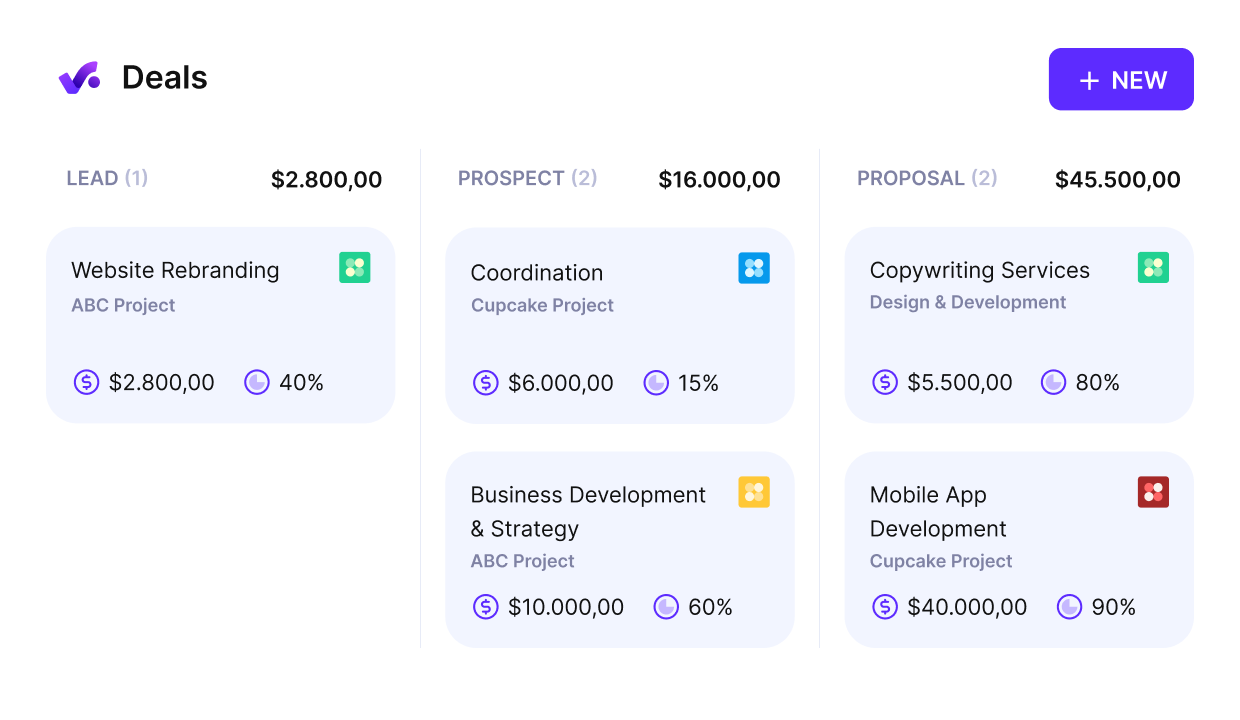
Productive shows you your sales pipeline and helps you prioritize future work.
Productive brings clarity to this process by letting teams tag and group projects by business impact, department, and priority. Leadership can use filters to review only the initiatives that map to current goals (making project selection more intentional and less reactive).
Replace 5 Tools With One Integrated Platform
Many teams run their work across a messy mix of tools. This usually looks something like: one tool for time tracking, another for workloads and tasks, something separate for budgeting, and spreadsheets to glue it all together.
But the more fragmented the stack, the harder it gets to trust the numbers or understand what’s really happening across a portfolio.
Productive replaces that clutter with a single, connected workspace. It combines project management, financial tracking, resource planning, and reporting in one platform.
As a result, your team gets a shared view of the work and the numbers behind it.
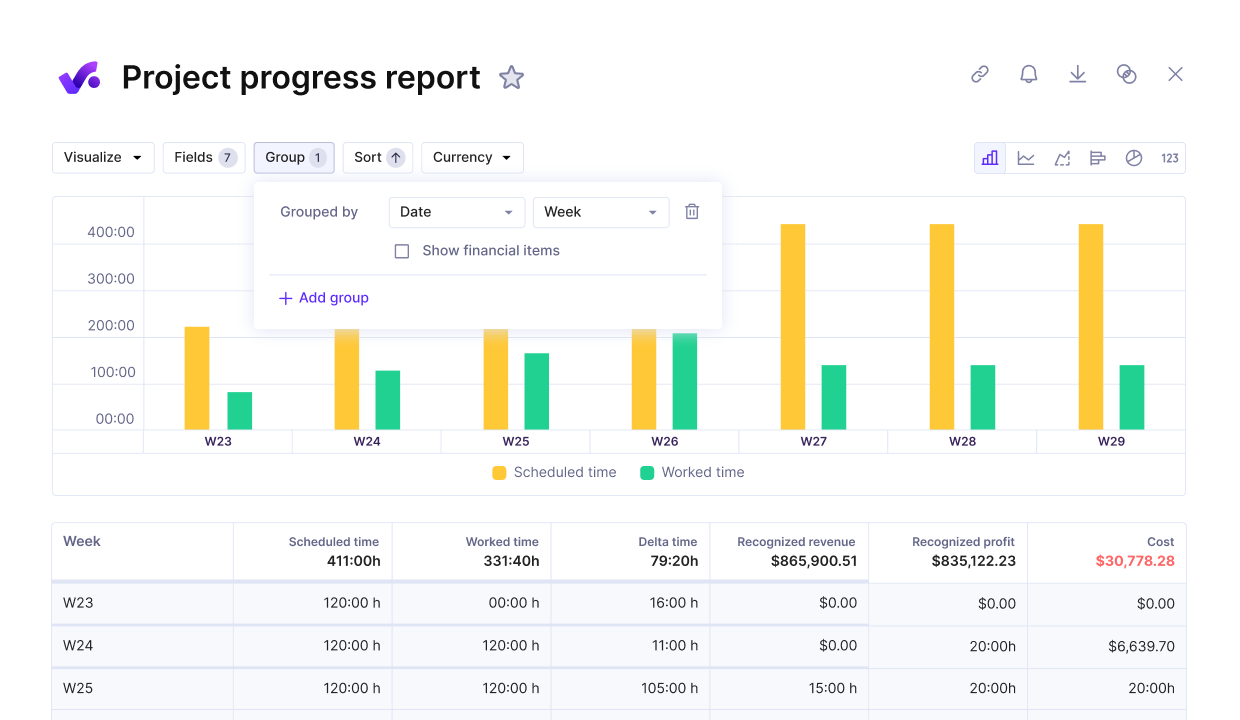
Track project progress and compare it to your key performance metrics in one view.
Pricing
- Plans start with the Essential plan at $9 per user per month, which includes essential features such as budgeting, project & task management, docs, time tracking, expense management, reporting, and time off management.
- The Professional plan includes custom fields, recurring budgets, advanced reports, billable time approvals, and many more for $24 per user per month.
- The Ultimate plan has everything that the Essential plan and Professional plan offer, along with the HubSpot integration, advanced forecasting, advanced custom fields, overhead calculations, and more for $32 per user per month.
Productive offers a 14-day free trial, so you can see what it can do for your project’s financial health.
Manage Every Project Portfolio From One Dashboard
Unify delivery, budgets, and capacity planning in one platform. Productive gives you full visibility across clients, teams, and subsidiaries – without spreadsheets.
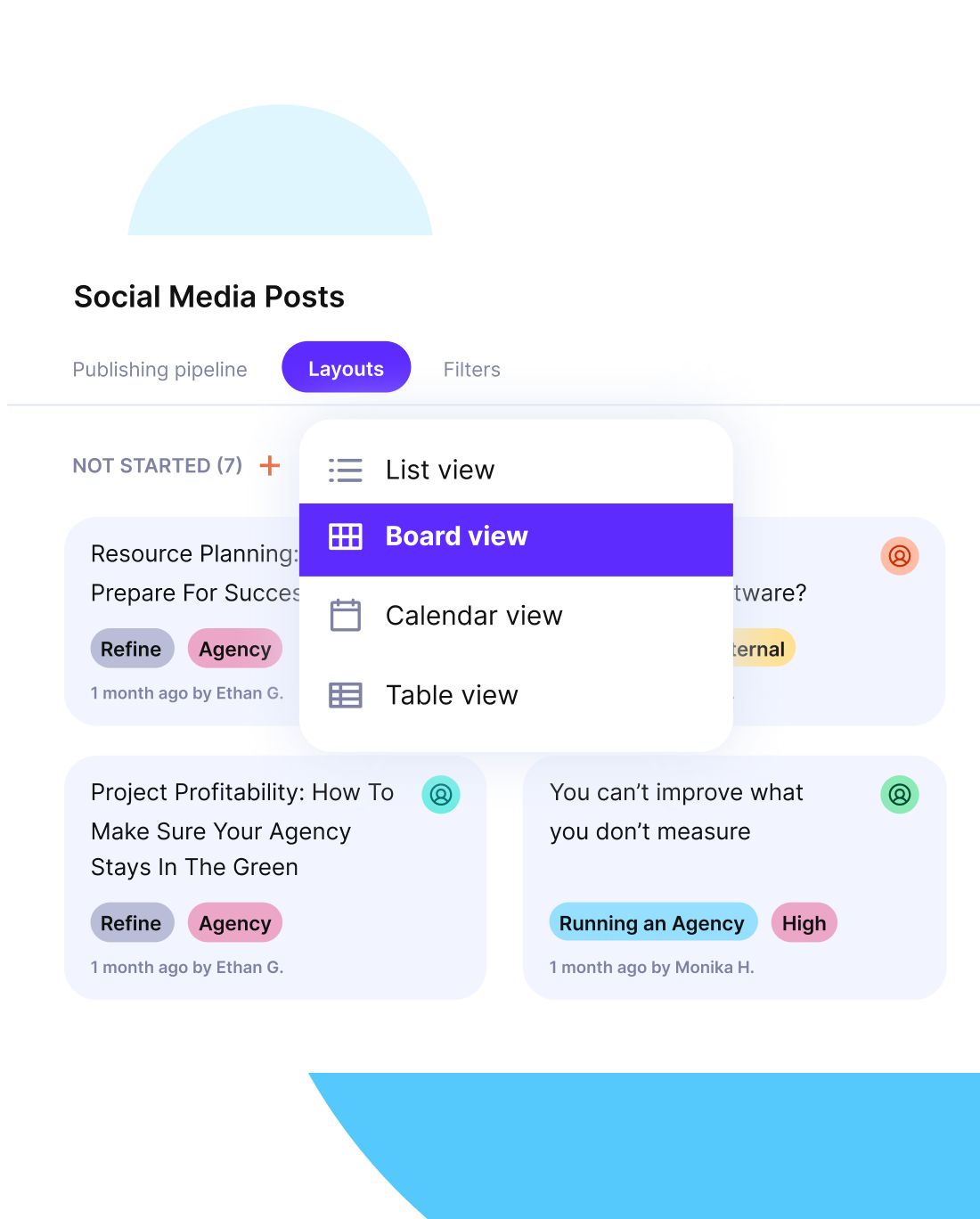
2. Celoxis – Best for Traditional PMOs and Structured Project Governance
Celoxis is a full-featured project portfolio management software designed for formal PMOs and delivery teams with defined workflows, approval processes, and cost controls.
It’s a good fit for organizations that prioritize governance and financial visibility.
Key Features
- Interactive Gantt charts with critical path analysis
- Role-based access and approval workflows
- Financial forecasting and billing tools
- Risk and issue tracking modules
- Portfolio dashboards and health metrics
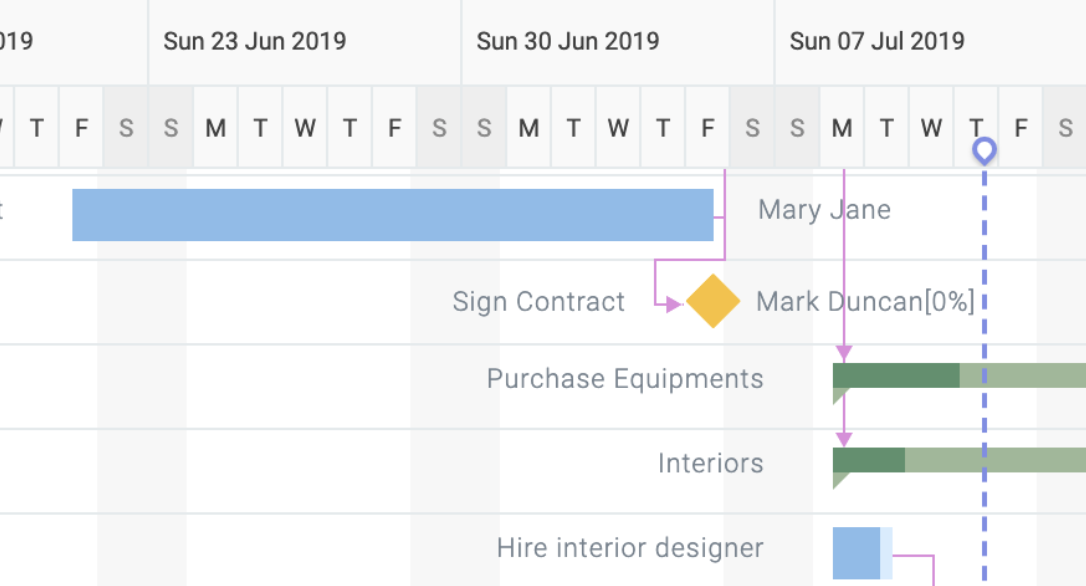
SOurce: Celoxis
User Feedback
Very big learning curve and confusing to navigate also poor ui and also some of the stuff is dated
Source: G2 Review
It is comprehensive, it definitely has potential but it needs to evolve more quickly. It feels clunky and outdated. It is not very visually appealing. It is so cumbersome to enter time sheets. Everyone hates doing their time sheets to begin with, it needs to be easy and fast to do.
Source: Capterra Review
Final Verdict
Strong on governance and portfolio control, but reviewers consistently cite a steep learning curve, dated UI, and slow, cumbersome timesheets. Best for PMOs that value depth and process rigor and can invest in training, not for teams prioritizing ease of use.
3. Smartsheet – Best for Spreadsheet-Native Teams and Marketing Departments
Smartsheet is a cloud-based project portfolio management software that combines familiar spreadsheet views with collaborative work tracking.
It’s especially useful for marketing teams and cross-functional departments that want flexibility without learning complex new systems.
Key Features
- Grid, card, calendar, and Gantt views
- Workflow automation with forms and conditional logic
- Portfolio dashboards and status reporting
- Content collaboration and file attachments
- Resource management (via add-on)

SOurce: Smartsheet
User Feedback
The cost isn’t worth it in my opinion. There are some great features but this is mostly just a glorified spreadsheet. A lot of what I used this platform for can be done in an online/collaborative xls.
Source: Capterra Review
Modular, customisable, fairly rapidly evolving platform. Familiar UI with many common features to Excel / MS products, so very easy to pick up and eventually master. Smartsheet is a bit lego-ish in that you can build more or less anything you want with a mid-level subscription.
Source: Capterra Review
Final Verdict
Familiar and highly configurable for teams that think in spreadsheets, with a modular, fast-to-adopt UI that can be shaped to many workflows.
Some users feel it is an expensive “glorified spreadsheet” for work they could handle in collaborative Excel, so it suits spreadsheet-native teams who value flexibility over advanced, out-of-the-box PPM depth.
4. Kantata – Best for Client-Focused Delivery and Workflows
Kantata (formerly Mavenlink) blends project portfolio management with professional services automation. It’s a solid fit for services firms that manage multiple clients, billable resources, and profitability targets across accounts.
By connecting delivery and financial data in one system, it helps operations leads control margins, reduce over-servicing, and improve overall project accountability.
Key Features
- Project tracking
- Budgeting and margin analysis
- Time and expense tracking
- Client invoicing
- Role-based permissions and reporting
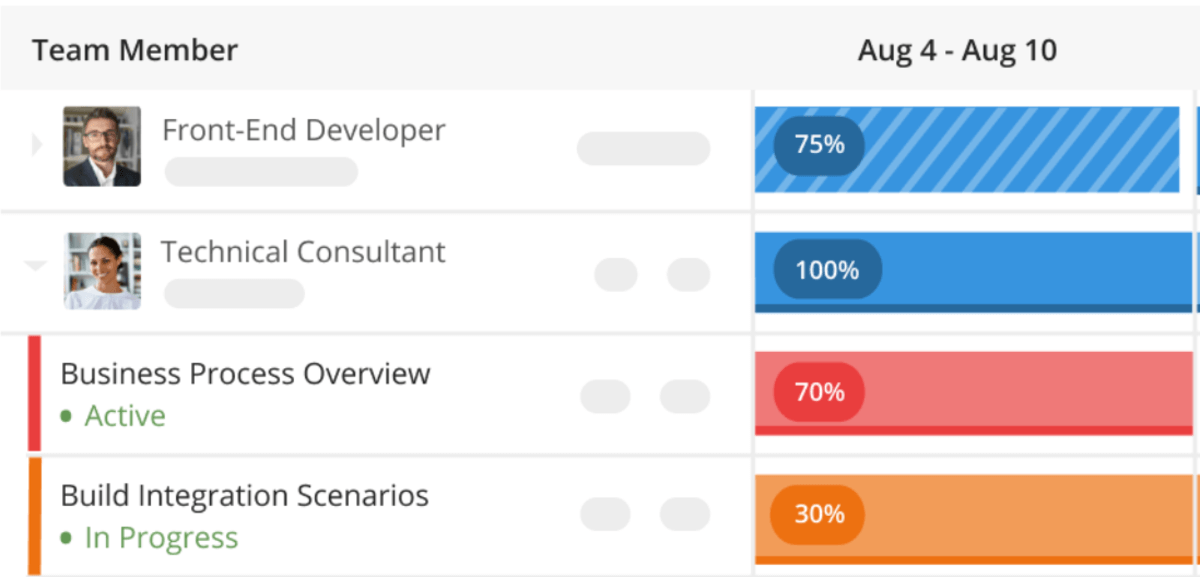
SOurce: Kantata
User Feedback
I am able to view tasks for current projects, track upcoming projects, add notes and tag team members easily in a very organized way that allows me to save time and resources on a regular basis.
Source: Capterra Review
It creates a lot of work for project managers. A lot goes into designing a project and filling it out, which is very time consuming. There is also a steep learning curve, especially if you are adapting to Mavenlink after being used to different systems. The trainings were somewhat helpful, but long, boring and repetitive.
Source: Capterra Review
Final Verdict
Strong for organized task tracking and team collaboration that can save time day to day, but several users report heavy project setup, administrative overhead, and a steep learning curve despite lengthy training.
Best for services teams that want tighter delivery-finance control and can dedicate PM capacity to configuration and ongoing upkeep. If you’re considering using this tool, you should definitely check out our big list of Kantata alternatives.
5. Bubble – Best for Innovation Portfolios and R&D-Heavy Teams
Bubble is built for organizations managing innovation portfolios, strategic initiatives, or early-stage product development. It’s especially useful for teams that need structured visibility into speculative work, where traditional project tracking tools fall short.
Key Features
- Initiative scoring and portfolio dashboards
- Stage-gate and roadmap planning
- Strategic alignment views
- Custom workflows and governance filters
- Scenario modeling and impact tracking
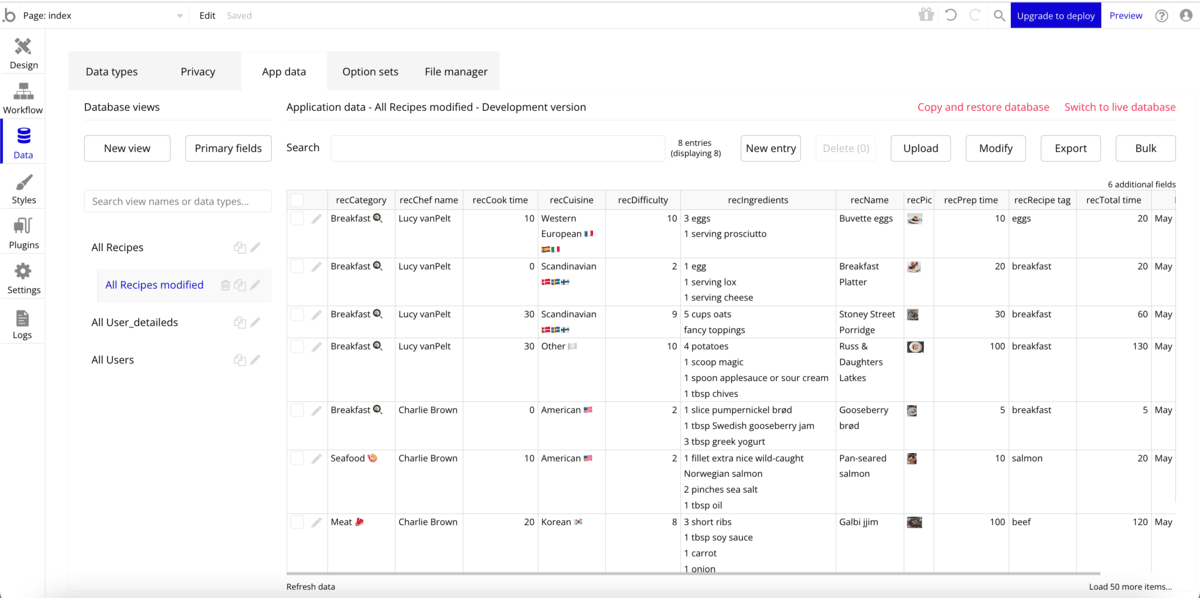
SOurce: Bubble
User Feedback
I would love to see better dashboard visual reporting in terms of graphs and charts with the ability to customise on company branded colours – this would save lots of time having to do this manually if I could take a PDF download of the graphs needed already with company branded colours. But other from that I have no complaints.
Source: G2 Review
Simplicity in capturing project information and customizing and displaying multiple project views. Easy to export information to Excel for further analysis.
Source: G2 Review
Final Verdict
Praised for simple data capture, flexible multi-view portfolios, and easy Excel export, Bubble suits teams that need structured innovation tracking without heavy setup.
Reporting customization is a gap, as reviewers want richer, brandable dashboards and one-click PDF outputs, so expect to supplement visuals with external tools.
6. Acuity PPM – Best for lightweight PMOs and executive-level visibility
Acuity PPM is designed for smaller PMOs or organizations building portfolio management capabilities from the ground up. It offers a clear, easy-to-adopt system that focuses on reporting, executive transparency, and streamlined workflows.
Key features:
- Interactive portfolio dashboards with traffic light indicators
- Visual project timelines and initiative tracking
- Project health scoring and risk flags
- Executive reports with exportable data
- Lightweight interface designed for speed and simplicity
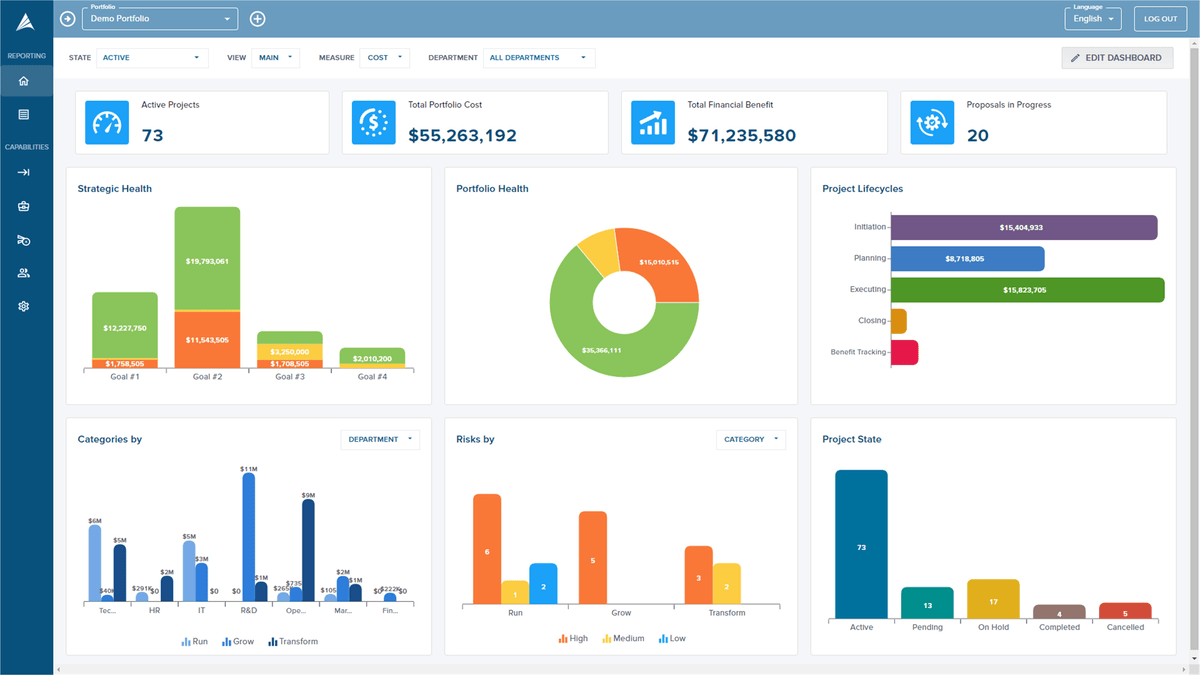
SOurce: Acuity PPM
User Feedback
There’s limited feature and more updates are required because it is a bit old fashioned and that affects the productivity. Other than it is sleek and efficient in every-way possible.
Source: G2 review
It has a clean, intuitive user interface that was accessible to my entire project team, regardless of computer expertise. The various built-in query and reporting visualizations make it easy to see the status of your whole portfolio.
Source: G2 Review
Final Verdict
Clean, intuitive dashboards make portfolio status easy to grasp across the organization, which suits lightweight PMOs that want visibility fast. Reviewers also note limited features and an old-fashioned feel, so it is less suitable if you need deep resourcing or advanced controls.
7. Planisware – Best for Enterprise-Scale Portfolios and Long-Range Strategic Planning
Planisware is an enterprise-grade project portfolio management platform built for organizations that manage high-stakes, long-term investments. It excels in complex environments where planning cycles, financial controls, and governance processes need to align across departments and programs.
This makes it a strong fit for IT, pharma, and manufacturing firms with multi-year planning horizons.
Key features:
- Stage-gate governance and lifecycle workflows
- Investment planning and prioritization tools
- Strategic roadmaps with KPI tracking
- Scenario modeling for long-term portfolio impact
- Custom reporting and compliance features
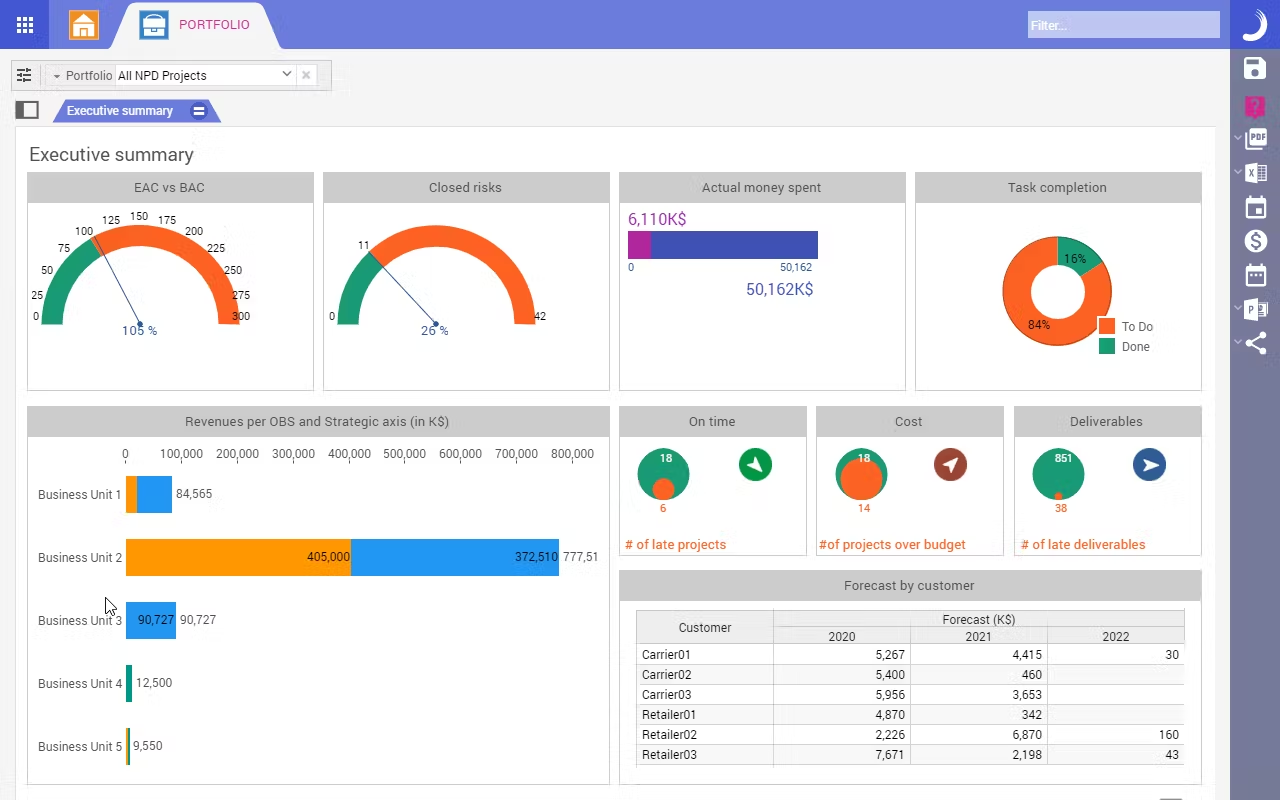
SOurce: Planisware
User Feedback
Integrations are a point that needs to be improved in future releases. Namely we’ll want to support high performance and close-to-realtime access to the data for downstream reporting. Planisware is right now limited to basic file-based integrations for mass movement of data.
Source: G2 Review
Planisware allows for a centralized place for portfolio data. It gives one the ability to view project data from approval to launch, including timelines, resources, and costs.
Source: G2 Review
Final Verdict
Strong at centralizing portfolio data across the full lifecycle with clear views of timelines, resources, and costs, which fits enterprise PMOs.
Reviewers flag limited, file-based integrations and a need for higher-performance, near real-time data flows for downstream reporting, so plan for integration work if your stack depends on live syncs.
8. OnePlan – Best for Microsoft-Native Organizations Needing Flexible Portfolio Coordination
OnePlan is a modular project portfolio management platform built for Microsoft-centric environments.
It integrates tightly with Microsoft Teams, Project, Azure DevOps, and Power BI – making it ideal for companies that want to extend their existing Microsoft stack with more robust planning, resourcing, and reporting capabilities.
Key features:
- Power BI powered portfolio dashboards
- Microsoft Teams and Planner integration
- Work planning across agile, waterfall, and hybrid projects
- Strategic planning and OKR alignment
- Resource planning and financial forecasting
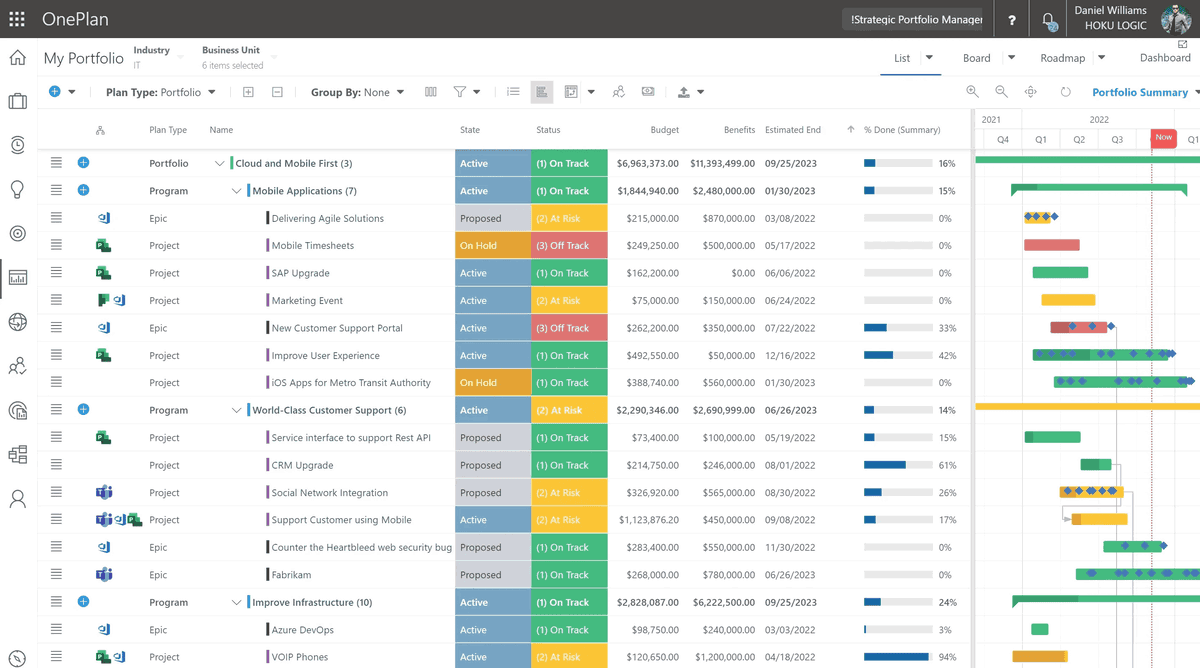
SOurce: OnePlan
User Feedback
OnePlan is simple to use for project management and resource tracking. Because it is a Microsoft product, you know it will get development cycles behind it and it will get better and better over time. Integrates with other MS tools very easily.
Source: G2 Review
There is a strong lack of communication. When there are issues in the system they notice they do not make us aware until we ask about them. Often times we have issues/tickets that take much longer to hear back on than our service agreement allows.
Source: G2 review
Final Verdict
Easy to use for project management and resource tracking, with deep Microsoft integration and a strong roadmap backed by the MS ecosystem.
Several users report slow support response and weak communication on incidents, so it fits Microsoft-native teams that value ecosystem alignment but can tolerate service delays.
9. Forecast – Best for AI-Powered Capacity Planning and Forecasting
Forecast is a modern project and resource management platform built for service-based companies that need automation, visibility, and profitability control across portfolios.
Forecast stands out for its use of AI to support smarter planning and real-time financial visibility.
Key features:
- AI-powered task and resource planning
- Capacity forecasting across portfolios
- Budget tracking
- Time tracking
- Native integrations with finance and CRM tools
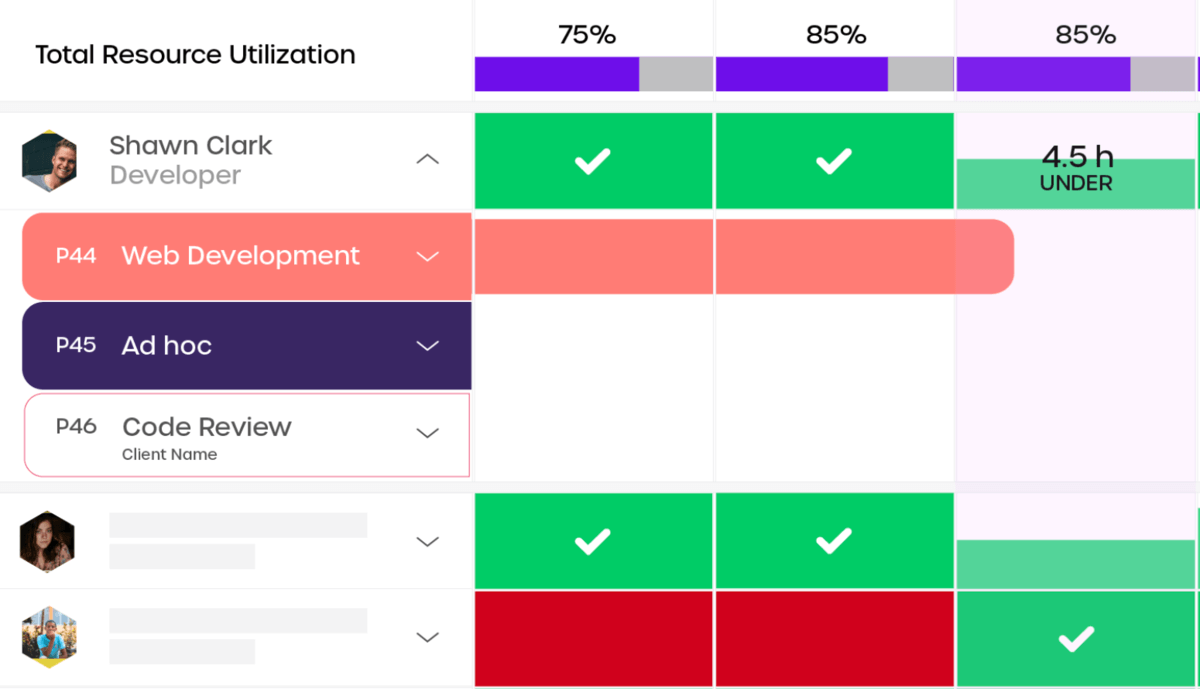
SOurce: forecast
User Feedback
There is a strong lack of communication. When there are issues in the system they notice they do not make us aware until we ask about them. Often times we have issues/tickets that take much longer to hear back on than our service agreement allows.
Source: G2 Review
There is a strong lack of communication. When there are issues in the system they notice they do not make us aware until we ask about them. Often times we have issues/tickets that take much longer to hear back on than our service agreement allows.
Source: G2 Review
Final Verdict
Combines approachable UX and quick time logging with strong analytics, which suits teams that want fast adoption and BI-ready metrics.
Reviewers note gaps in planning basics such as dependent rescheduling, audit history, and recurring multi-person scheduling, so confirm these needs during trials.
10. Deltek – Best for Compliance-Driven Delivery and Government Contractors
Deltek is a project portfolio management solution tailored to firms that operate under strict regulations and audit requirements – especially in government contracting, aerospace, and engineering.
It brings delivery, billing, and compliance into one system, helping teams stay client-ready and audit-proof.
Key features:
- Project cost accounting and contract compliance tools
- Time and expense tracking with audit trails
- Government-specific billing formats and approval workflows
- Risk and opportunity tracking dashboards
- Pre-built templates for common federal and state reporting standards
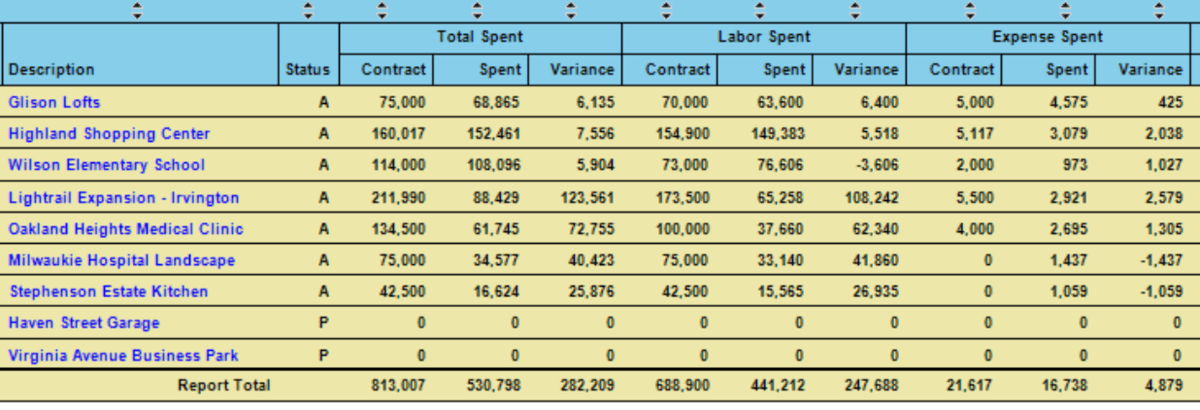
SOurce: deltek
User Feedback
There is a strong lack of communication. When there are issues in the system they notice they do not make us aware until we ask about them. Often times we have issues/tickets that take much longer to hear back on than our service agreement allows.
Source: Capterra Review
There is a strong lack of communication. When there are issues in the system they notice they do not make us aware until we ask about them. Often times we have issues/tickets that take much longer to hear back on than our service agreement allows.
Source: Capterra Review
Final Verdict
Best for compliance-heavy environments that pair it with tools like Oracle Primavera to assess schedule quality and meet industry standards. Expect high implementation costs and a dated, clunky interface that may frustrate users.
11. Triskell – Best for Highly Configurable Portfolios and Evolving Enterprise Needs
Triskell is a highly customizable project portfolio management software designed for enterprises that need flexibility across strategy, execution, and resource planning.
It works best for organizations that want to model complex portfolios and evolve their PPM processes over time without changing tools.
Key features:
- Fully configurable data models and workflows
- Portfolio scoring and initiative prioritization
- KPI dashboards with drill-down views
- Strategic planning and investment alignment
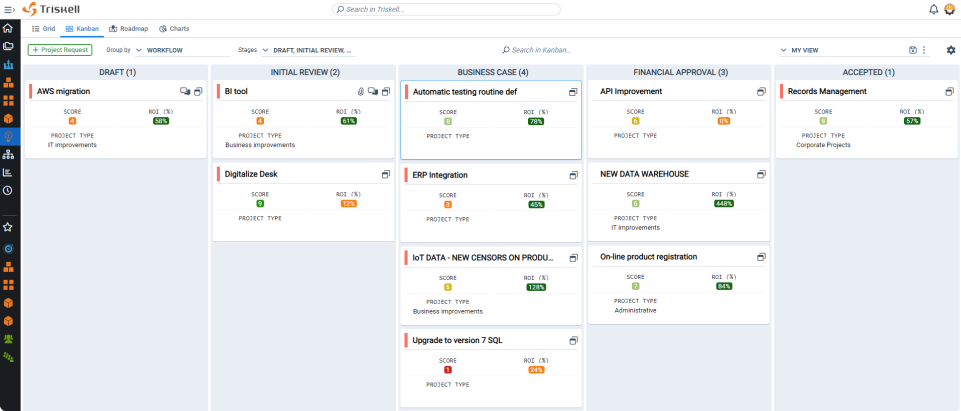
SOurce: Triskell
User Feedback
The software is not fully customisable to meet their specific needs. Additionally, experience difficulties integrating Triskell PPM with other tools and systems.
Source: G2 Review
Easy friendly, intuitive, great to use by both IT and Business
Source: Capterra Review
Final Verdict
Easy and intuitive for both IT and business users, making it a workable choice for organizations that want configurable portfolio views without heavy training.
Reviews also point to limits in customization and integration challenges, so confirm your required data flows and specific configurations during evaluation.
12. NH360 – Best for Centralized Decision-Making and Executive-Level Portfolio Oversight
NH360 is built for leadership teams that need reliable, portfolio-wide insights to support strategic decisions. It works best for organizations managing multiple business units or departments, where centralized visibility and consistent evaluation criteria are essential.
Its interface emphasizes clean dashboards, initiative tracking, and governance clarity.
Key features:
- Cross-portfolio dashboards with unified metrics
- Business unit–level tracking and rollups
- Executive reporting with strategic KPIs
- Scoring models for initiative evaluation
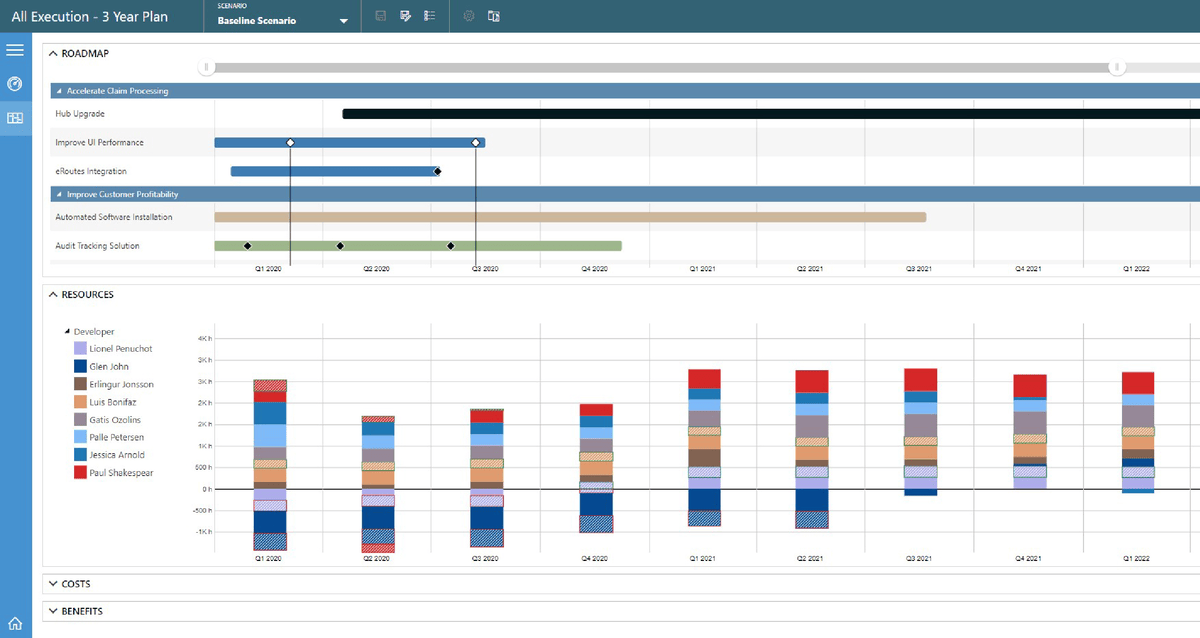
SOurce: NH360
User Feedback
Excellent team members and willing to define needed configurations/customizations. Nice features for visualizations. Configurations meet unique needs and flexible to support multi-currency. Challenges: No out of the box features, configuration is complex and a lack of reporting.
Source: Gartner Review
Final Verdict
Strong visualizations and flexible, multi-currency configuration, with a responsive team that helps tailor the setup.
Expect few out-of-the-box templates, complex configuration, and limited reporting, so it fits organizations that can invest time in customization to support executive-level oversight.
13. Sciforma – Best for Regulated Industries With Structured Governance Needs
Sciforma is designed for organizations that require structured oversight, compliance-ready reporting, and clear project governance. It’s a strong fit for healthcare, finance, and manufacturing teams that operate under strict standards and need auditable delivery processes.
Key features:
- Risk registers and compliance-ready audit trails
- Project scoring, prioritization, and health tracking
- Configurable workflows and stage-gate approvals
- Portfolio-level reporting and financial summaries
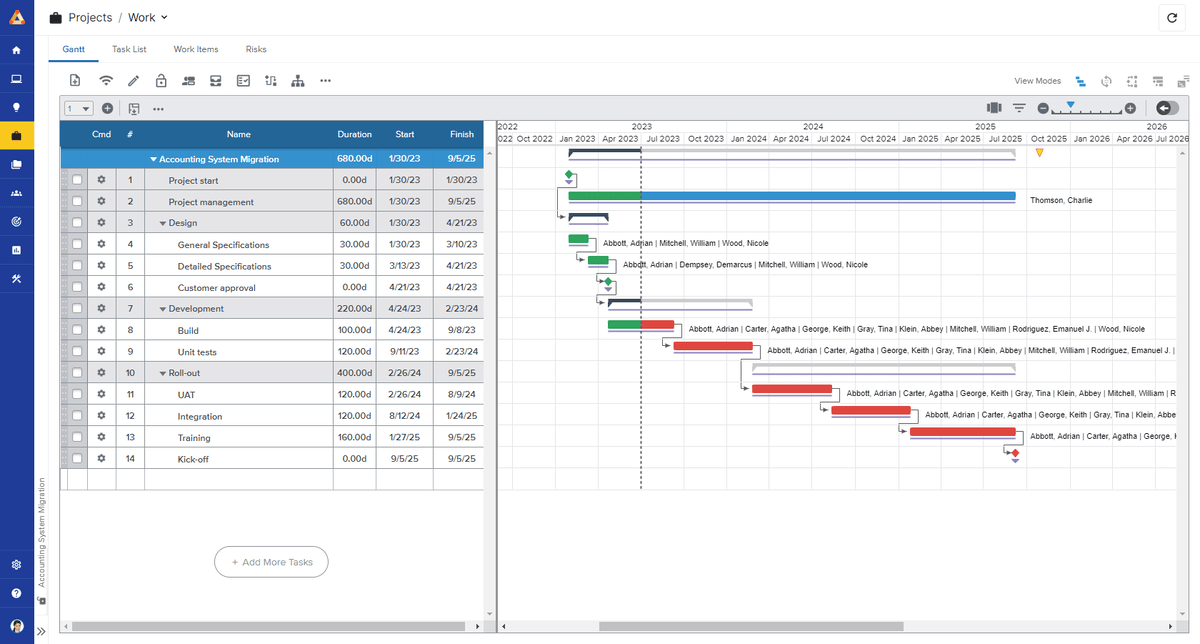
SOurce: Sciforma
User Feedback
Even though the interface is simple (in a good way) you can get deep analysis (i.e cost analysis, resource utilization, etc). It is very easy to navigate and I recommend this tool in companies that have employee that are change averse.
Source: G2 Review
It takes a bit too much time to get formatting and printing properly configured – too many options. The API can also be tricky, but useful once you have the hang of it.
Source: G2 Review
Final Verdict
Simple to navigate yet capable of deep analysis like cost and utilization, which helps change-averse teams adopt portfolio controls without friction.
Expect setup time for formatting and printing and a learning curve on the API, so plan for initial configuration before scaling usage.
14. Jira – Best for Agile Product Teams Scaling Cross-Project Delivery
Jira is a leading project and issue tracking platform built for software development and Agile delivery teams. It’s best suited for organizations running multiple Agile squads that need to coordinate across sprints, epics, and programs.
Jira’s flexibility, native backlog workflows, and integrations with Jira Align make it a powerful option for scaling agile portfolios.
Key features:
- Scrum and Kanban boards for team-level delivery
- Advanced backlog and sprint planning tools
- Jira Align for cross-team program coordination
- Roadmaps for strategic alignment and delivery tracking
- Rich ecosystem of integrations (DevOps, Git, Confluence)
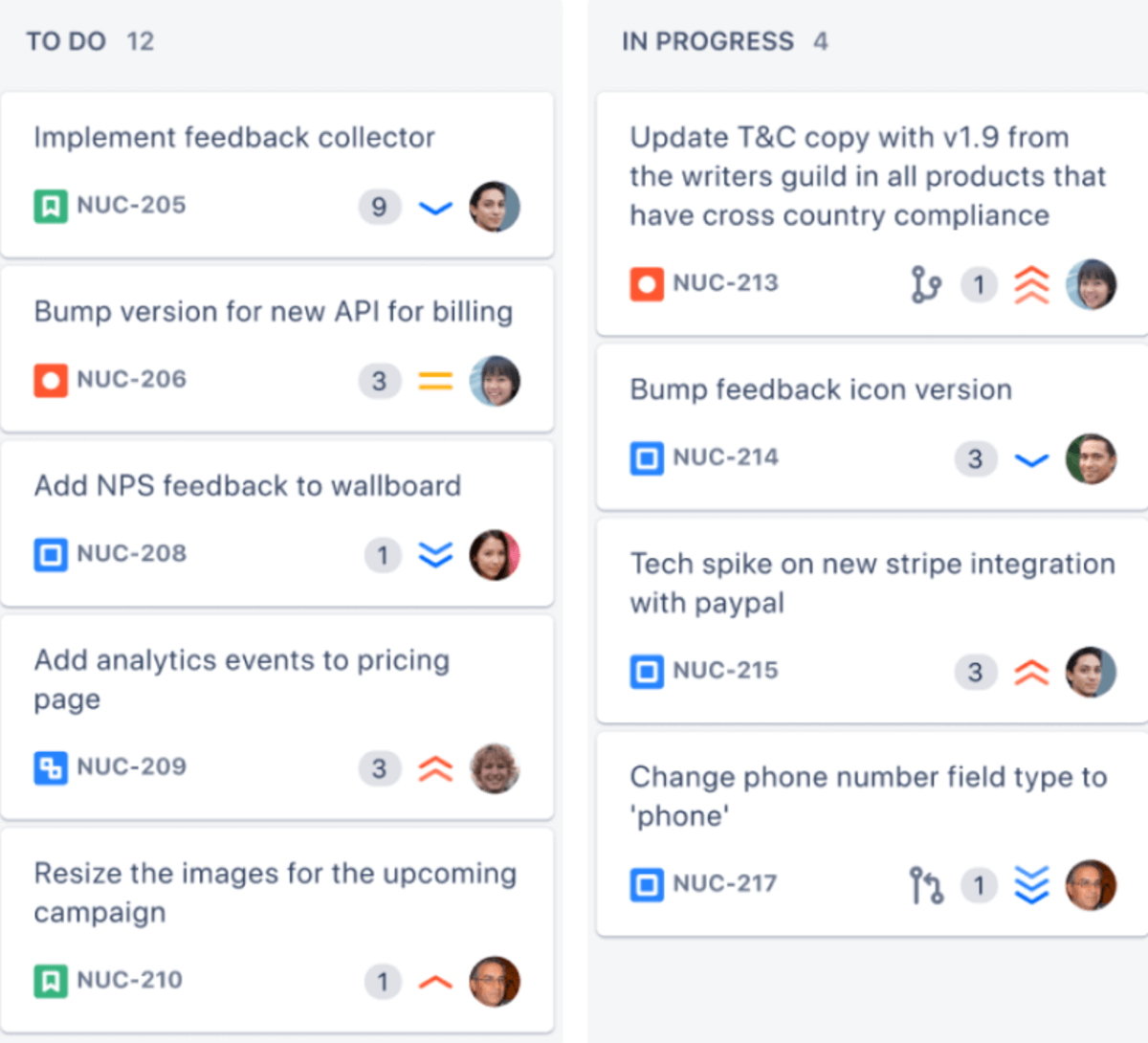
SOurce: jira
User Feedback
While Jira has solid core features for customizing projects and tickets, it can feel overly complex when it comes to advanced features like automation or scripting. The learning curve for non-technical users is steep, and it would be great if some of the more powerful functions were more user-friendly and accessible for a broader audience—not just engineers or those comfortable with code.
Source: G2 Review
What I like about Jira is how it helps visualize progress in a way that’s meaningful for both teams and stakeholders. The traceability it offers with being able to link epics, stories, tasks and bugs into a clear hierarchy makes it easy to see how everyday work contributes to broader goals.
Source: G2 Review
Final Verdict
Excellent for visualizing work and maintaining traceability from epics to bugs, which helps teams connect daily tasks to broader goals.
Reviewers warn that advanced features and automation feel complex, and the learning curve is steep for non-technical users, so it suits engineering-led teams with time to configure and support it.
15. ProofHub – Best for fast-growing teams needing an all-in-one project & portfolio control
ProofHub is an all-in-one project and portfolio management platform that combines planning, execution, collaboration, and reporting in a centralized workspace.
It’s a strong fit for fast-scaling organizations, cross-functional teams, and client-servicing agencies that want complete visibility across projects, seamless collaboration, and full control in one place.
Key features:
- Kanban, Gantt, Table, and Calendar views
- Built in chat, discussion boards, file attachments, and proofing
- Custom roles, access controls, and custom workflows
- Time tracking, timesheets, and workload visibility
- Project status, task completion, and resource reports
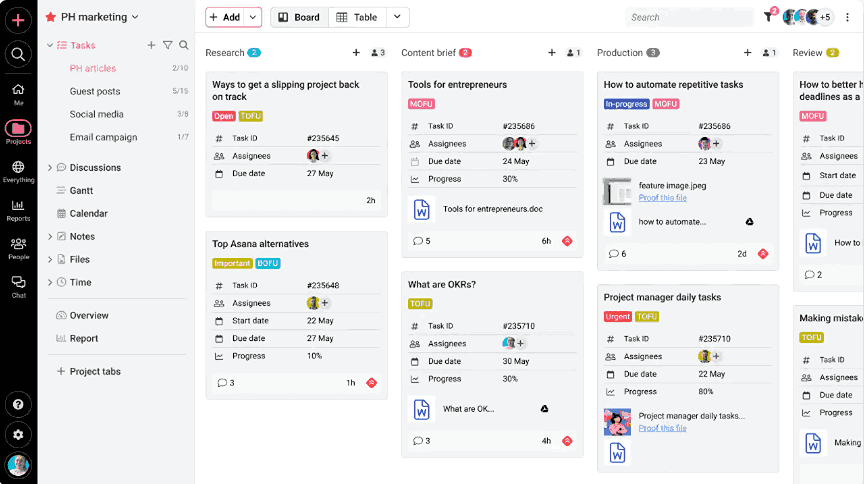
SOurce: proofhub
User Feedback
ProofHub keeps all our campaigns, content calendars, and design feedback in one place. I love how easy it is to create tasks, set deadlines, and keep conversations focused within each project. The discussions, proofing, time tracking, and file-sharing features save us from endless email chains. The clean interface, minimum learning curve, and flat pricing make onboarding new team members smooth.
Source: G2 Review
ProofHub has been my favorite project management tool of all time. The feature I love the most is proofing, which allows me to give feedback on all marketing content or simply approve it without ever leaving the platform. I used to do it through emails, which wasted a lot of my time and that of my team. Now, I can focus on what matters most – delivering quality work. However, it would be better if notifications were made a little more user-friendly.
Final Verdict
Excellent for planning, executing, and managing project portfolios in one place, helping teams move faster and stay aligned.
While some users request more advanced integrations, ProofHub provides all the necessary features without any added complexity.
16. Microsoft Planner – Best for Internal Teams Needing Simple Task Coordination
Microsoft Planner is a lightweight project management software designed for teams already using Microsoft 365.
It’s ideal for internal departments and smaller teams that need simple task tracking, status updates, and basic collaboration without the complexity of full-scale PPM platforms.
Key features:
- Visual task boards with drag-and-drop functionality
- Assignments, checklists, and due dates
- Shared plans integrated with Microsoft Teams
- Comments, attachments, and file previews
- Seamless Microsoft 365 permissions and security
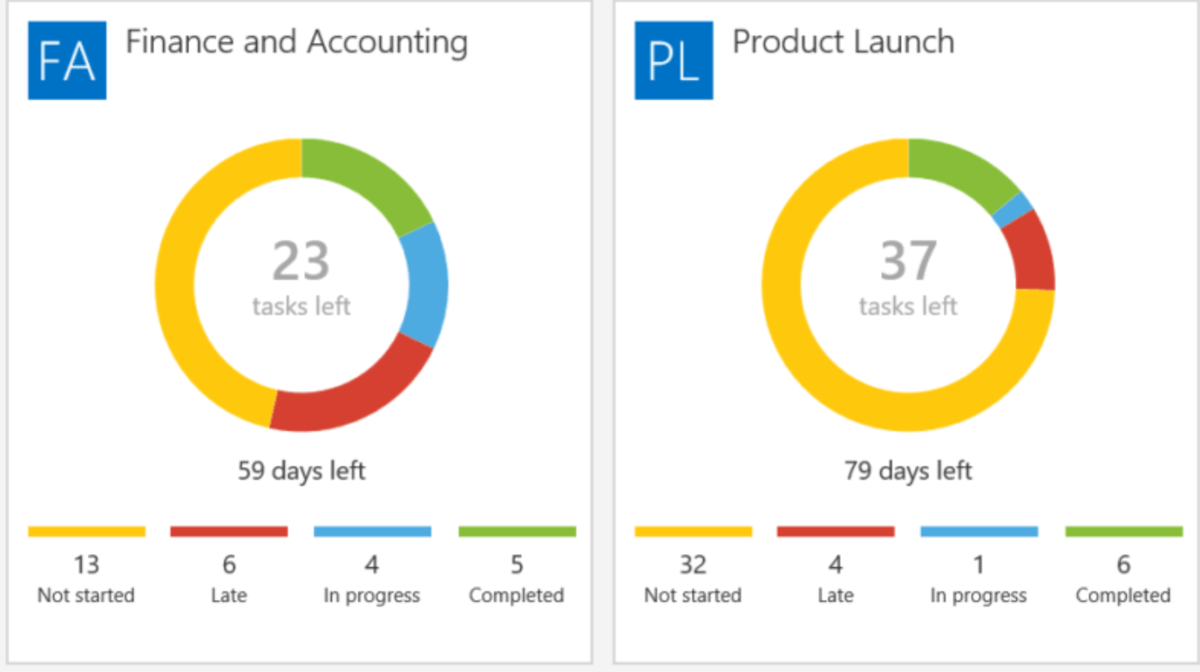
SOurce: Microsoft Planner
User Feedback
It’s complex. Everything in the M365 tools has its learning curve, and the same goes for Planner. In Planner, you can do wonderful things, but they are never intuitive. I wish Planner were more intuitive like the competition.
Source: G2 Review
Easy to organise tasks and assignments. User friendly and easy to navigate to various options. Automated mail alerts on tasks updates. Tracking of progress of tasks and percentage completion.
Source: G2 Reviews
Final Verdict
Handy for simple task coordination inside Microsoft 365, with easy assignments, progress tracking, and email alerts that keep teams aligned. Several users find it non-intuitive with a learning curve, so it suits lightweight internal projects rather than complex portfolio management.
How To Choose the Right Project Portfolio Management Software?
The best way to choose project portfolio management software is to align your choice with how your organization operates (not just what features look good on paper).
You need a tool that supports the way you prioritize, plan, and resource work across teams. That means focusing on real workflows, decision ownership, and financial visibility, not just a checklist of capabilities.
Here’s how to break that process into three clear, repeatable steps you can apply to your own team.
Step 1: Start with your operating model
Look at how your organization makes decisions, not just how you track tasks. Start by mapping your actual decision-making flow.
The goal here is to identify who reviews incoming project proposals, who approves funding, and who tracks delivery across departments.
In many companies, that’s a mix of operations leads, department heads, and finance. Identify what each role actually needs to operate effectively:
- Operations leads need to see resource capacity and allocation in real time.
- Department heads need portfolio-wide visibility into deadlines, risks, and blockers.
- Finance needs accurate forecasts and up-to-date actuals across all projects.
Based on these needs, define your top five non-negotiable features, and use them to immediately filter out any tools that don’t support them out of the box.
Step 2: Test real workflows
Don’t just skim the feature list. Instead, take one or two of your active portfolios and walk them through the tool in a trial or live demo. Start by adding real client or project data, so that you can test how the platform handles visibility, resource planning, and financials.
Then simulate your standard workflows: assigning team members, forecasting hours, checking margin reports, and sharing updates with leadership. If the tool breaks down under realistic use, it’s not a fit.
This is how you pressure-test tools before committing.
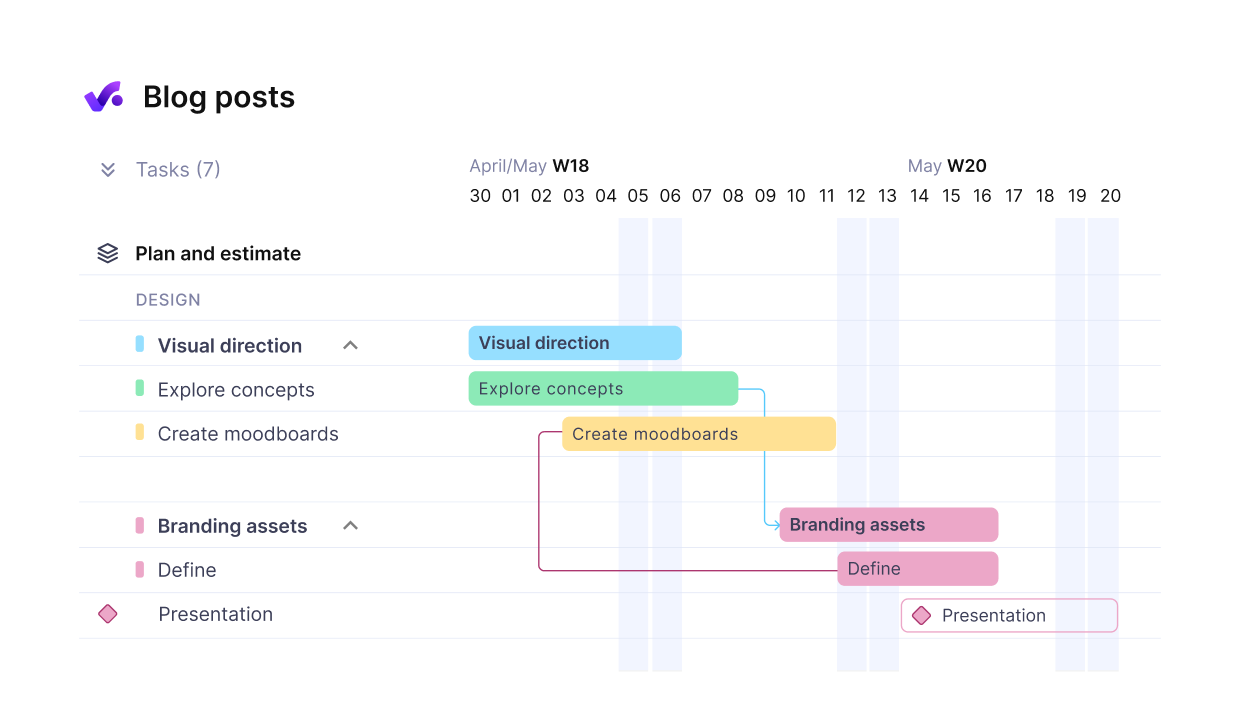
Set up workflows with dependant tasks in Productive.
Step 3: Match tools to planning style
Now take what you’ve defined (workflows, roles, and non-negotiable features), and match them against how each tool actually supports planning, reporting, and coordination.
Don’t pick software based on name recognition or review count. Compare it by the things that will shape daily work: how it helps prioritize projects, manage resources across departments, and pull out portfolio-level insights.
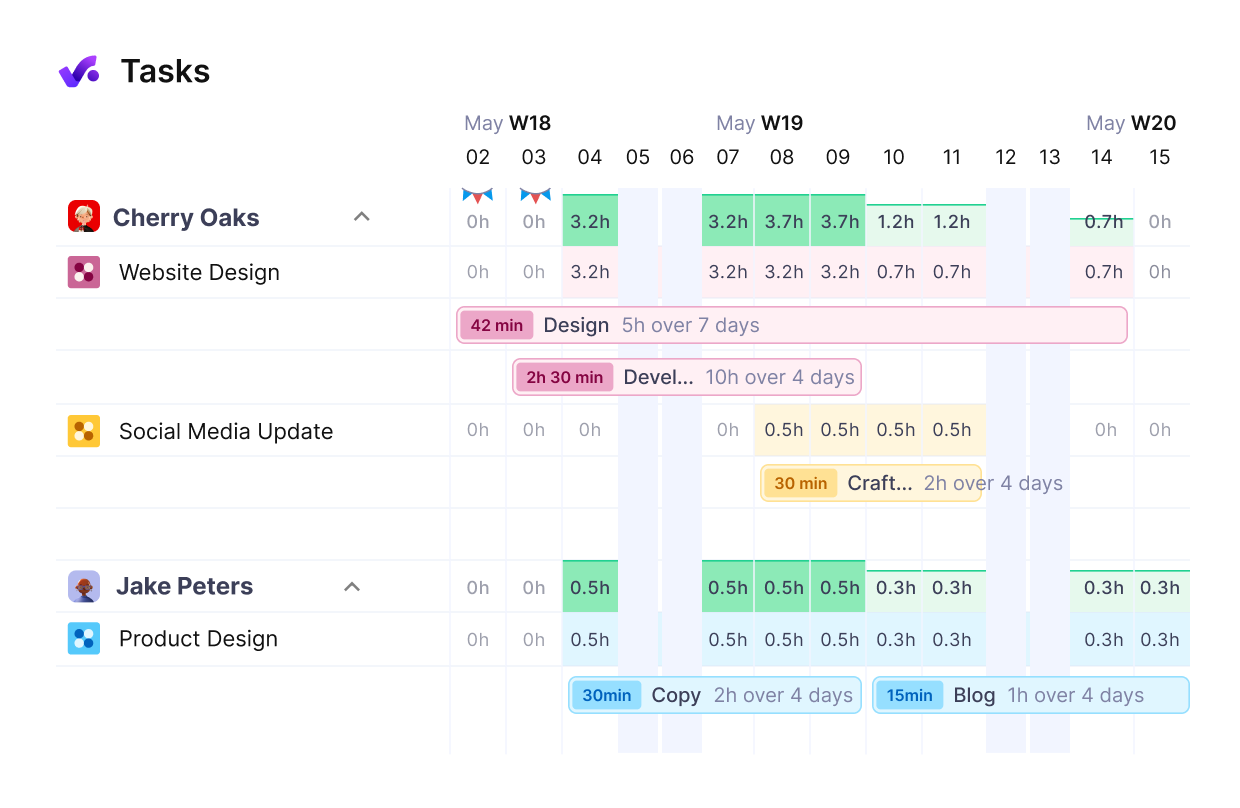
Get real-time overviews of your team’s workloads.
Then use the table below to benchmark options by five core criteria that matter in day-to-day portfolio operations:
- Can you track resource allocation across multiple projects?
- Do you get financial visibility at both the project and portfolio level?
- Does the reporting system give execs what they need without manual exports?
- Can the tool enforce strategic prioritization during intake?
- How long does it take to get teams onboarded and running?
Use the table as a shortcut to find the tools that best match your structure, scale, and planning needs.
| Tool | Best For | Resource Planning | Financial Tracking | Reporting Depth | Ease of Use |
|---|---|---|---|---|---|
| Productive | Agencies that need one platform for delivery, finance, and strategy | Yes | Yes | Yes | Yes |
| Smartsheet | Teams moving from spreadsheets to structured tracking | Yes (add-on) | No | Yes | Yes |
| Kantata | Service businesses managing client delivery and billing | Yes | Yes | Yes | Moderate (setup required) |
| Bubble | Companies managing innovation or strategic portfolios | Limited | No | Yes | Yes |
| Acuity PPM | Lightweight PMOs needing visibility and reporting | No | No | Yes | Yes |
| Planisware | Enterprises with multi-year planning and governance needs | Yes | Yes | Yes | Low (complex) |
| OnePlan | Microsoft-native teams with hybrid delivery models | Yes | Yes | Yes | Yes (if MS-native) |
| Forecast | Agencies focused on capacity planning and profitability | Yes | Yes | Yes | Moderate (setup required) |
| Deltek | Compliance-heavy firms and government contractors | Yes | Yes | Yes | Low (dated interface) |
| Triskell | Enterprises needing high configurability | Yes | Yes | Yes | Low (requires admin support) |
| NH360 | Executive teams tracking strategy and business unit performance | Partial | No | Yes | Yes |
| Sciforma | Regulated industries with strong audit needs | Yes | Yes | Yes | Low (rigid setup) |
| Jira | Agile development teams scaling across squads | Partial (via Align) | No | Yes | Moderate (steeper learning) |
| Microsoft Planner | Small internal teams needing simple task coordination | No | No | No | Yes |
What Are the Benefits of Project Portfolio Management Software?
The benefits of project portfolio management software are that it helps leadership teams prioritize the right work, allocate resources efficiently, and monitor performance across multiple projects in one place.
Below, we’ll expand on those benefits:
- Tie every project to strategic goals. PPM software connects delivery with high-level business objectives, making it easier to evaluate work based on impact (not just deadlines).
- Plan resources across teams and portfolios. Instead of manually tracking who’s overbooked or idle, you get real-time visibility into capacity and planned utilization across all units.
- Track budget health and profitability. With built-in financial dashboards, teams can monitor burn, margins, and forecasted revenue at both project and portfolio levels.
- Replace fragmented tools. Many teams juggle separate systems for tasks, time tracking, resourcing, and reporting. Some PPM tools combine them into one connected workflow.
- Make faster, better-informed decisions. Custom dashboards and portfolio views help leadership teams surface risks, spot blockers, and adjust course based on real-time data.
What Are the Downsides of Project Portfolio Management Software?
The downsides of project portfolio management software include steep setup requirements, added complexity for smaller teams, and hidden costs that can inflate total ownership.
While powerful, these tools aren’t always practical without the right structure and internal support.
Here’s what to watch out for:
- Setup time and complexity. Enterprise-grade platforms often require weeks of configuration, role setup, and internal training. If you don’t have a dedicated admin or change management plan, you’ll likely underuse the tool.
- Too complex for simple teams. If you’re not tracking financials or managing cross-department portfolios, a full-scale PPM platform might introduce unnecessary overhead.
- Steep learning curve. Tools designed for PMOs or heavily regulated industries may confuse cross-functional teams who just need clear timelines and resourcing.
- Unplanned costs. Some platforms rely on paid add-ons for essentials like reporting, resource planning, or integrations. All these fancy and mandatory add-ons will inflate your total cost of ownership.
What Is Project Portfolio Management Software?
Project portfolio management (PPM) software is a system that helps organizations manage multiple projects as a unified portfolio rather than treating each one in isolation.
It gives decision-makers a centralized way to evaluate progress, balance resources, and align projects with broader strategic goals.
This type of software typically includes tools for planning, prioritization, budgeting, capacity tracking, and executive reporting. Unlike traditional project management tools, PPM software is built for scale.
It supports visibility and control across departments, clients, or business units and helps leaders make better-informed decisions at the portfolio level.
Final Thoughts on Tools For Managing Project Portfolios
There’s no strategic portfolio management without the proper tool kit. So far, we’ve covered the best PPM software options for different use cases.
Productive brings delivery, operations, and finance of your complete project portfolio into one workspace. You get centralized planning, portfolio-level reporting, and clear visibility into margins and capacity.
Explore Productive or book a demo to see it in action.
FAQ
What does project portfolio management software do?
It centralizes how you plan, track, and manage multiple projects at once, with built-in visibility into resources, budgets, timelines, and business goals.
How is PPM software different from project management tools?
Project management software helps individual teams plan and deliver work. PPM software provides a portfolio-level view across all projects, helping leadership optimize resources, align strategy, and monitor performance across the organization.
Who should use PPM software?
It’s best suited for agencies, enterprises, or PMOs managing multiple projects, programs, or departments that share resources and require strategic alignment.
Is PPM software worth it for smaller teams?
If you’re managing more than five projects at once, especially across clients or business units, the added visibility and structured reporting often justify the investment.
What’s the easiest PPM tool to use?
Smartsheet and Productive are often the most intuitive options for teams new to PPM. Enterprise-level platforms like Planisware or Triskell offer more depth but require more setup and training.
Connect With Agency Peers
Access agency-related Slack channels, exchange business insights, and join in on members-only live sessions.

